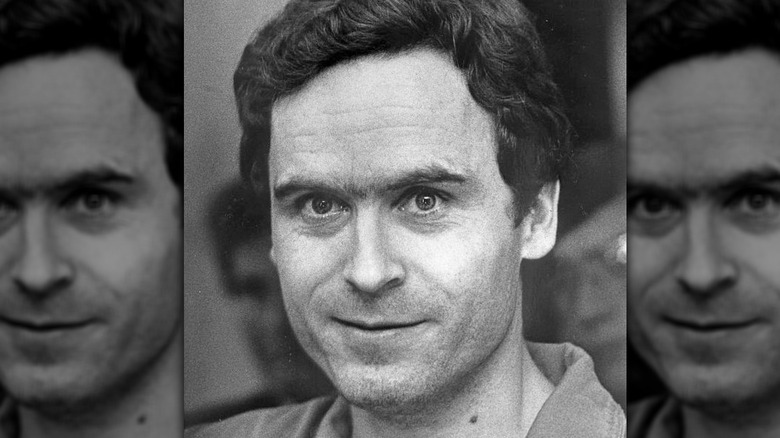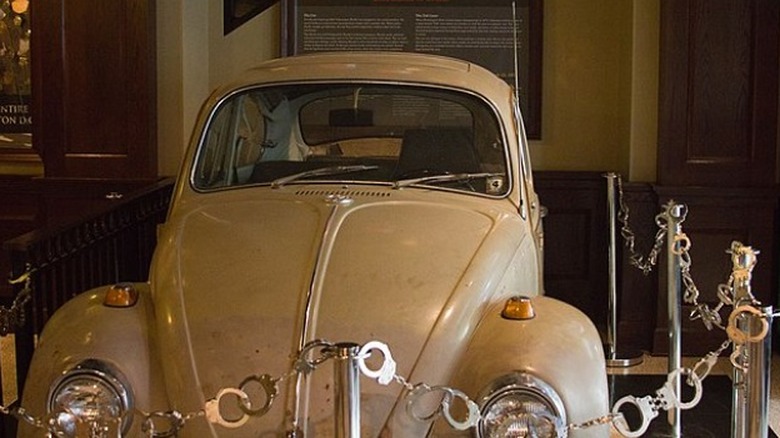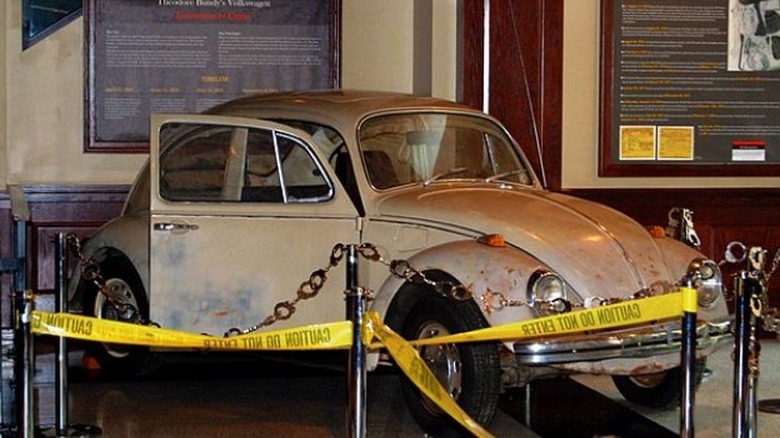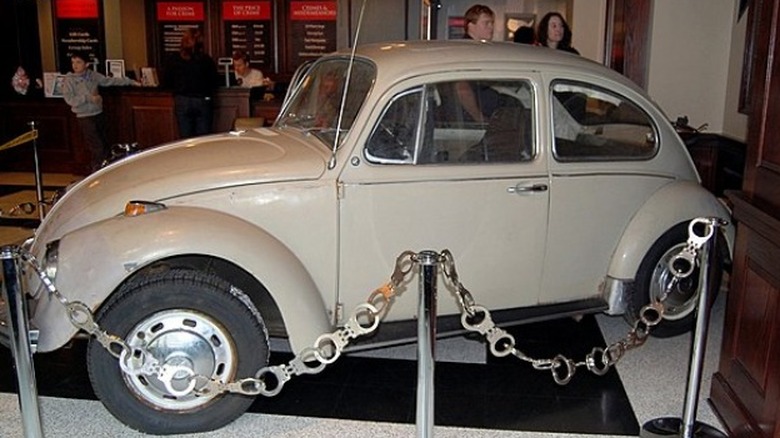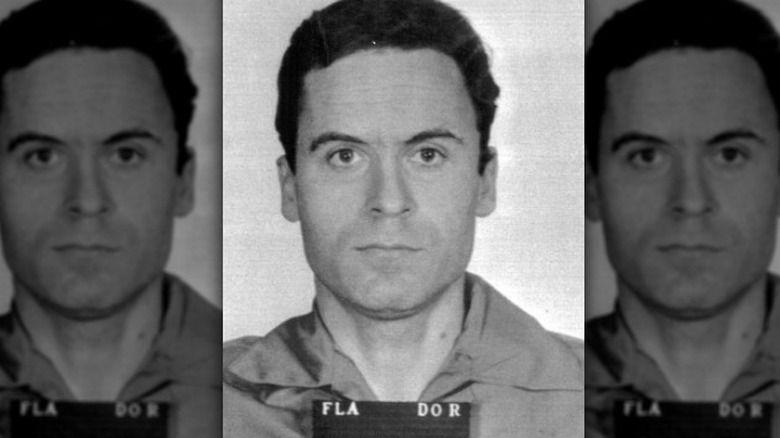What Happened To Ted Bundy's Car?
There are have been some notorious cars in American criminal history. There's the white Ford Bronco that O.J. Simpson rode in during the infamous low-speed chase in 1994; the bullet-riddled V8 Ford that had been commandeered (read: stolen) by Bonnie and Clyde, and in which they met their demise in a barrage of gunfire at the hands of law enforcement; and many more. Few, however, carry a story as sordid as the '68 Volkswagen Beetle driven by Ted Bundy, one of America's most notorious serial killers.
By the time he was convicted, Bundy admitted responsibility for 28 murders, but according to Britannica, some estimate he could be responsible for hundreds more. Bundy is also noted for his multiple prison escapes and his ability to elude capture until he was arrested for the final time in 1978, sentenced to death in 1979, and executed in the electric chair in 1989. Bundy had already committed murders in the Pacific Northwest when, according to All That's Interesting, Bundy relocated to Utah toward the end of the summer of 1974, where he would commit a series of additional murders. For these killings, he had an additional resource at his disposal: that unassuming, tan Beetle.
Ted Bundy's rolling torture chamber
There's arguably no car less threatening vehicle than the Volkswagen Beetle. Even from a design perspective, its rounded, curved features are nothing like those typically associated with aesthetic appointments considered to be intimidating or scary — like sharp corners and jagged edges — but throw Ted Bundy behind the wheel of anything and it becomes exponentially scarier. According to All That's Interesting, Bundy's Beetle was not just a means of transportation; he used it as a tool in his horrific crimes. He was known to have faked injuries to garner sympathy from victims, going so far as to don a sling or hobble around on crutches.
Once an unwitting victim took his bait, he'd knock them out and push them into the car. This trait would inspire a similar methodology used by the fictional serial killer Buffalo Bill in the 1991 Oscar-winning movie "The Silence of The Lambs." The interior of Bundy's Volkswagen Beetle was heavily modified to suit his deranged needs. The passenger's seat and the door handle were both removed, allowing Bundy a place to lay an unconscious victim out of sight with no means of escape should they wake up. It's believed that at least 11 of Bundy's victims met the unfortunate fate of seeing the inside of one of history's most notorious cars, reports Scripps Howard Foundation Wire.
The Beetle helped bring down Bundy
Considering the role Bundy's car played in his crimes, it's all the more fitting that it was a major contributor to his downfall and eventually his execution. Police pulled Bundy over in 1975 for driving without headlights. According to Scripps Howard Foundation Wire, police were immediately suspicious of the unusual modifications to the Beetle. They then found a series of items that would indicate to anyone that the person in possession of them was up to some kind of nefarious activities: handcuffs, a ski mask, an ice pick, and pantyhose with eye holes cut out of them.
Bundy was arrested at that time on suspicion of burglary. Soon out on bail, Bundy attempted to clean the car of all evidence related to his murder spree, and then sold the Beetle to teenagers in Utah, as Car and Driver explains. What eventually led to his downfall? One year earlier, Bundy had attempted to abduct Carol DaRonch, but though Bundy had handcuffed her inside the Beetle, she escaped. DeRonch picked Bundy from a police lineup, and the Beetle was then impounded by the police from the new owner. Forensic teams found evidence in the car such as blood and hair from three women Bundy killed.
The car changed hands a few times
Bundy would escape from prison twice — committing more murders while on the lam — before being apprehended for good in Florida in 1978. (In one instance where Bundy escaped, he stole a 1972 Beetle from the home of Rick Garzaniti near Tallahassee, Florida. The car was later returned to Garzaniti with the backseat missing, according to Car and Driver.) But while the story of Ted Bundy the bloodthirsty serial killer ends with his execution in 1989, the story of his Volkswagen Beetle continues to this day.
According to The Seattle Times, in the late 1970s, Lonnie Anderson, a former sheriff's deputy, bought Bundy's Beetle at auction in the late 1970s. In 1997, Anderson put the car up for sale in a classified ad in The New York Times for $25,000. At that time, Anderson said he had several inquiries, having described it as a "one-of-a-kind vehicle." According to The Seattle Times, Anderson also said, "I bought it as an investment and I think the time is ripe to sell ... I know there are [victims'] families out there right now. But I bought it for a purpose and I'll take all the heat that comes as long as that money goes in the bank."
The Beetle went on tour
The family of Bundy's victims took exception to Anderson's decision to cash in on such macabre memorabilia. Utah resident Belva Kent whose teenage daughter, Debi, was killed by Bundy said (via The Seattle Times), "I just can't imagine what kind of person would do this." Don Blackburn of Washington State, whose daughter was also murdered by Bundy, said, "On a personal basis, I think this is quite sadistic. It's not something I'd expect a law-enforcement man to do. It repulses me."
According to Car and Driver, Bundy's car was purchased by Arthur Nash, a collector of dark historical artifacts, in 2001, to add to a collection that consists of gangster-related pieces, per The New York Times. In 2010, the car, leased by Nash, would then make an appearance at the National Crime And Punishment Museum in Washington D.C., which closed four years later. While still listed as a part of that museum's collection, it has been loaned to Pigeon Forge, Tennessee's Alcatraz East Crime Museum alongside John Wayne Gacy's paintbox and O.J. Simpson's white Ford Bronco. Based on Car and Driver reporting, Bundy's Beetle is still owned by Nash.
